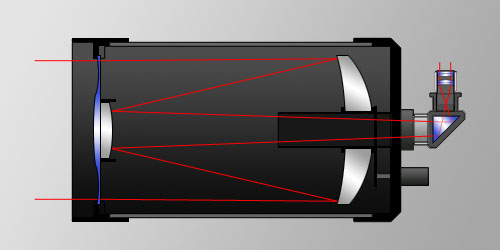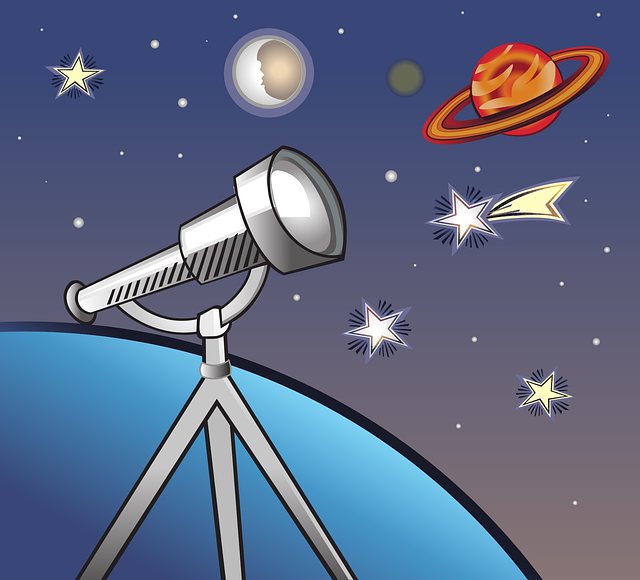*This post may contain affiliate links. This means we may make a commission if you purchase an item using one of our links*
If you’re just getting into the world of amateur astronomy, you might be a bit inundated with the myriad of different options available in terms of telescopes. Right off the bat, you’ll have to choose whether you want a reflecting, refracting, or catadioptric telescope, and within each of these three main telescope types, there are literally dozens of different sub types.
There are several differences between Schmidt-Cassegrain and Dobsonian telescopes, but the main one is that Schmidt-Cassegrain telescopes are catadioptric, while Dobsonian telescopes are reflecting. As a result, both of these telescopes have advantages and disadvantages in certain areas.
Today, we’ll be comparing Schmidt-Cassegrain telescopes to Dobsonian telescopes and explaining in detail how they are different and in what areas each of these telescopes excel.
How Does a Schmidt-Cassegrain Telescope Work?
Table of Contents

A Schmidt-Cassegrain telescope, as we’ve stated, is a catadioptric telescope sub-variation. This means that it’s a telescope that produces images through the use of both lenses and mirrors, in contrast with refracting telescopes that only use lenses and reflecting telescopes that only use mirrors.
Schmidt-Cassegrain telescopes belong to the greater sub type of Cassegrain telescopes, which all work in generally the same way. In a Schmidt-Cassegrain telescope, light enters through the main aperture, passes through a corrector lens, and then hits the concave primary mirror located at the back of the telescope.
The light is then reflected towards a smaller convex secondary mirror, which redirects the light through a hole in the primary mirror and into the telescope’s eyepiece. This method of “folding” the light inside a Schmidt-Cassegrain telescope allows it to be physically smaller than some other comparable telescopes.
There are several other types of Cassegrain telescopes, all of which generally function in the same way but have slight differences in terms of their specific hardware setup.
For example, Schmidt-Cassegrain telescopes have a convex corrector lens and a normal secondary mirror, while Maksutov-Cassegrain telescopes, another popular Cassegrain telescope, have spherical corrector lenses, and use an aluminized spot on the corrector lens itself in place of a secondary mirror.
How Does a Dobsonian Telescope Work?
![]()

As we’ve mentioned, Dobsonian telescopes are reflective telescopes, meaning they rely entirely on mirrors to generate images. Dobsonian telescopes do contain a small focuser lens near the eyepiece, but this doesn’t really affect the quality of the image in the same way that a corrector lens in a Schmidt-Cassegrain telescope would.
Dobsonian telescopes are pretty simple in terms of how they work. Light enters through the main aperture of the telescope and reflects off of a primary mirror at the telescope’s other end. This light then hits a secondary mirror which in turn sends it through the focuser lens and into the eyepiece.
There are a few additional characteristics of a Dobsonian telescope that set it apart from other reflective telescopes. The first is the fact that Dobsonian telescopes all use an alt azimuth mount, which allows the telescope to be moved on a vertical and horizontal axis simultaneously.
Dobsonian telescopes also tend to be pretty large on average, but they’re also relatively lightweight and cheap thanks to the materials they use. In particular, Dobsonian telescopes are often made with thinner mirrors than other reflective telescopes, and their main tubes are often made with materials like heavy-duty cardboard.
What Are the Differences Between a Schmidt-Cassegrain and a Dobsonian Telescope?
Aside from the differences in how these telescopes are made and how they operate, Schmidt-Cassegrain and Dobsonian telescopes also have quite a few unique differences in terms of how they can be used and what exactly they’re good for.
For starters, Dobsonian telescopes usually have a shorter focal length than Schmidt-Cassegrain telescopes. This means that Dobsonian telescopes have a wider field of view than Schmidt-Cassegrains, but as a result, their magnification isn’t as strong.
Dobsonians, despite being physically larger, are both lighter and less expensive than Schmidt-Cassegrains, thanks to their choice of materials. However, since they’re so much larger, they’re less portable as a result.
Because Dobsonian telescopes have such wide apertures, they’re able to capture a lot more light than Schmidt-Cassegrain telescopes, which results in a brighter image with more vibrant colors. However, the design of Schmidt-Cassegrain telescopes typically results in a more accurate image overall with fewer aberrations.
What Are the Benefits of Choosing One Over the Other?
Each of these two telescopes has several advantages and disadvantages. Let’s take a minute to compare these two and see how they stack up against each other.
If you’re a total novice when it comes to astronomy and you’re looking for a telescope that is easy to use and cheap to own, your best bet is likely going to be a Dobsonian telescope.
While a Dobsonian isn’t going to give you the same level of magnification that you’d get from a Schmidt-Cassegrain, it should still be good enough for observing other planets, the moon, and anything else in space that reflects light that is sufficiently bright and as a result easier to observe.
However, due to their wide apertures, Dobsonian telescopes aren’t particularly good for inner-city use as they don’t cope too well with the ambient light present there. If you’re planning on mainly using your telescope within city limits, a Schmidt-Cassegrain might be the better option here.
In addition, the large size of Dobsonian telescopes means that they’re not very easy to move from place to place. If you’re planning on bringing your telescope to multiple locations to do some stargazing, you might want to go with something physically smaller like a Schmidt-Cassegrain.
Lastly, because Schmidt-Cassegrain telescopes are better at eliminating comatic aberration, they ultimately produce more accurate images than Dobsonian telescopes.
Summary
In general, novice astronomers are better suited going for Dobsonian telescopes as it’s significantly cheaper yet can produce excellent views of the night sky but, if you’ve a little more experience stargazing, you might want to step up to a Schmidt-Cassegrain set-up .
In the end of the day the telescope best suited for you will depend on several factors, whether it be your budget restrictions, your location, and what you plan on actually using your telescope for.
References
https://www.astronomyscope.com/dobsonian-vs-cassegrain/
https://telescopeguides.com/schmidt-cassegrain-vs-maksutov-cassegrain/

